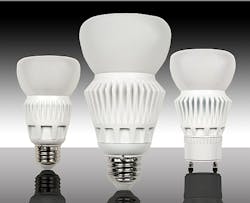EPA details LED-centric changes coming to Energy Star Lamps V1.1 (UPDATED)
The US Environmental Protection Agency (EPA) is closing in on what has seemed to be a marathon-like push to establish the Energy Star Lamps V1.0 specification, and has now announced some expected changes coming in V1.1 that are particularly relevant with regard to LED-based replacement lamps. Specifically, the agency will make some changes related to lamps that might pass for A19 products but that are targeted at decorative applications and also will add provisions for AC-mains-powered MR16 lamps.
The Energy Star Lamps V1.1 specification is on pace to take effect this September, after the EPA went through an arduous series of drafts while accepting input from stakeholders on the specification-development process. Last August the agency finalized the specification and a relatively quiet period has ensued on the lamps front.
Related articles:
EPA publishes final Energy Star Lamps V1.0 specification
EPA publishes the final draft of the Energy Star Lamps specification
EPA releases draft 4 of the Energy Star Lamps V1.0 specification
The changes being previewed for V1.1 are either targeted at making sure consumers get the expected level of performance for Energy Star rated products, or at lamp types not currently covered in the specification. The EPA is asking for feedback on the proposed changes by June 20, 2014.
There are three primary changes. First, the EPA plans to specifically exclude G18.5 and G19 LED lamps from the Energy Star program whereas those products can currently win an Energy Star rating in the decorative category. But consumers could easily mistake those products for omnidirectional A-lamps and expect the type of energy efficiency and performance expected of A19 lamps. Therefore, the program will no longer include the specialty products.
The EPA said, "It remains EPA’s intent to provide consumers with efficient replacement lamps without sacrifice in performance and not award the Energy Star label to products that emulate the look of incandescent bulbs (e.g., A19, A21) but fail to deliver the necessary light distribution to adequately replace currently installed lamps."
The second change focuses on adding coverage of GU10-based MR16 lamps that are powered from the AC mains voltage. Those lamps were previously excluded because there was no standardized shape outline for such lamps specified by the American National Standards Institute (ANSI). But ANSI is working on two new MR16-type lamp standards: one allowing more space for driver and thermal components and one based on the IEC GU10 standard. Moreover, the National Electrical Manufacturers Association (NEMA) and other stakeholders have requested that the GU10-type lamps be included.
The final change is focused on PAR30 lamps. The EPA will now allow manufacturers to test just the short-neck version of a PAR30 lamp and apply that data to regular- and long-neck versions, with all versions getting Energy Star recognition.





